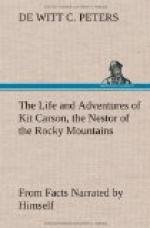The brook trout are the fish which mostly inhabit
them, and, a singular fact, in many of these streams
this kind of fish treat the presence of a man with
perfect indifference, which has led me to believe,
that in their primitive state, the “shy trout”
fear neither man nor beast. The Indians catch
them, and it may be that this fish is first frightened
by them. In the Rocky Mountains, south of the
head waters of the Arkansas, comparatively speaking,
there are but few small birds and squirrels.
The raven, the crow, the hawk, the owl, and occasionally
the eagle, are seen. Wild geese, ducks, and cranes,
are common. Pigeons, including the wild dove,
are not often seen. The magpie is found in abundance.
Turkeys and grouse are also in abundance. Wild
rabbits and a species of hare are also common.
Indeed a man can travel for days in the Rocky Mountains
and never hear the musical notes of a bird. In
these mountains, rattle-snakes are only found in the
valleys, where it is warm. In the summer, the
deer and elk live in the mountains; but, when cold
weather sets in, they are driven out of them by the
deep snows. The antelope of the plains seek the
mountain valleys during the winter. The buffalo
migrate south as the season becomes too severe for
them. Sometimes they are caught by the storms,
and are obliged to winter also in the mountain valleys.
The pine trees of the Rocky Mountains bear a small
nut, which is called by the Mexicans
pinon,
which, when cooked, are quite pleasant to the taste.
There are many small salt lakes in the mountains, and
many marshes, where the ground is covered white by
the salt deposit. The mineral wealth of the Rocky
Mountains is very great, and there is no doubt but
some day, rich veins of gold, silver, and iron ore
will be discovered there. The geological formation
of the country is such as to warrant this belief.
Nearly every stream carries down in its floods that
precious metal, gold; but, in such small quantities,
as not to attract the attention of miners. I
have found there, on the surface of the earth, small
pieces of material resembling stone coal, which have
probably been thrown up by some volcanic action.
Hot and mineral springs are not unfrequently met with.
They are places of frequent resort by the Indians,
who use them for medicinal purposes.
CHAPTER IX.
Kit Carson concludes to become a Farmer—He is joined in the
Enterprise by a Friend—They build a Ranche on the Cimeron
River—Descriptions of Mexican Customs and Country—Fremont
once more at Bent’s Fort—Express sent for Kit Carson to
join the Expedition as Guide—The Ranche Sold, and
the Departure—The Third Expedition and
its Explorations—Difficulties with the
Mexican-Californians—General Castro’s Orders to leave the
Country—Determination to Fight—Fremont goes to Lawson’s
Fort—Fremont and his Men encounter a Thousand Indians—The
Battle and the Victory—The news that War had been
declared between the United States and Mexico reaches
Fremont—Lieutenant Gillespie rescued from the Indians—Three
of the party killed in the Night by Indians—The Savages
repulsed—The Burial of Comrades.




